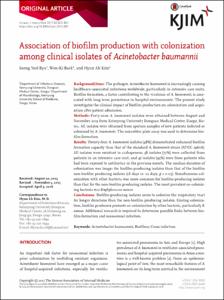KUMEL Repository
1. Journal Papers (연구논문)
1. School of Medicine (의과대학)
Dept. of Internal Medicine (내과학)
Association of biofilm production with colonization aming clinical isolates of Acinetobacer baumannii
- Alternative Author(s)
- Ryu, Seong Yeol; Kim, Hyun Ah; Baek, Won Ki
- Journal Title
- Korean Jouranl of Internal Medicine
- ISSN
- 1226-3303
- Issued Date
- 2017
- Keyword
- Acinetobacter baumannii; Biofilms; Cross infection
- Abstract
- Background/Aims: The pathogen Acinetobacter baumannii is increasingly causing
healthcare-associated infections worldwide, particularly in intensive care units.
Biofilm formation, a factor contributing to the virulence of A. baumannii, is associated
with long-term persistence in hospital environments. The present study
investigates the clinical impact of biofilm production on colonization and acquisition
after patient admission.
Methods: Forty-nine A. baumannii isolates were obtained between August and
November 2013 from Keimyung University Dongsan Medical Center, Daegu, Korea.
All isolates were obtained from sputum samples of new patients infected or
colonized by A. baumannii. The microtiter plate assay was used to determine biofilm
formation.
Results: Twenty-four A. baumannii isolates (48%) demonstrated enhanced biofilm
formation capacity than that of the standard A. baumannii strain (ATCC 19606).
All isolates were resistant to carbapenem, 38 isolates (77%) were collected from
patients in an intensive care unit, and 47 isolates (95%) were from patients who
had been exposed to antibiotics in the previous month. The median duration of
colonization was longer for biofilm-producing isolates than that of the biofilm
non-biofilm producing isolates (18 days vs. 12 days, p < 0.05). Simultaneous colonization
with other bacteria was more common for biofilm-producing isolates
than that for the non-biofilm producing isolates. The most prevalent co-colonizing
bacteria was Staphylococcus aureus.
Conclusions: Biofilm-producing isolates seem to colonize the respiratory tract
for longer durations than the non-biofilm producing isolates. During colonization,
biofilm producers promote co-colonization by other bacteria, particularly S.
aureus. Additional research is required to determine possible links between biofilm
formation and nosocomial infection.
- Publisher
- School of Medicine
- Citation
- Seong Yeol Ryu et al. (2017). Association of biofilm production with colonization aming clinical isolates of Acinetobacer baumannii. Korean Jouranl of Internal Medicine, 32(2), 345–351. doi: 10.3904/kjim.2015.287
- Type
- Article
- ISSN
- 1226-3303
- Appears in Collections:
- 1. School of Medicine (의과대학) > Dept. of Internal Medicine (내과학)
1. School of Medicine (의과대학) > Dept. of Microbiology (미생물학)
- 파일 목록
-
-
Download
 oak-2017-0293.pdf
기타 데이터 / 291.25 kB / Adobe PDF
oak-2017-0293.pdf
기타 데이터 / 291.25 kB / Adobe PDF
-
Items in Repository are protected by copyright, with all rights reserved, unless otherwise indicated.